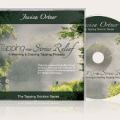 Imagine that you’re having an incredible day (or maybe you already are and don’t have to imagine 🙂 )… It’s one of those days when you feel your best, and everything is going smoothly.
Imagine that you’re having an incredible day (or maybe you already are and don’t have to imagine 🙂 )… It’s one of those days when you feel your best, and everything is going smoothly.
You come home at the end of the day feeling great, energized by all the positive things that have happened in just this one day. But then, after dinner, you open your mail, and find a bill that’s much, much higher than you ever could have imagined. Suddenly, you’re in a state of panic, full of fear and anxiety.
Within seconds, the one bad experience of your day – getting an enormous bill – has overpowered hours and hours of positive experiences.
The truth is, we’ve all had some, if not several, versions of that day. The question is, how can a single negative experience so easily overpower an entire day of positive ones?
In a culture that encourages us to be, or at least appear, positive, it’s something a lot of us don’t feel comfortable talking about, but the truth is, feeling positive doesn’t always come naturally. In fact, more often than not, it’s a LOT of work! Many of the most positive people I know are that way because they constantly work on themselves.
They use tapping, meditation, yoga – often all of those combined (and more!) – to clear the negative emotions they naturally experience. Because of the time and attention they dedicate to their emotional well-being, they’re then able to feel more positive more often.
Before we look at how to do that, it’s important to understand why it’s so much easier for us to focus on one bad experience instead of multiple positive ones.
It’s what neuropsychologist and New York Times best-selling author Rick Hanson, Ph.D. calls the brain’s “negativity bias.” In a nutshell, the “negativity bias” began as protective mechanism, a mental “habit” that helped us survive. Because this bias started so long ago, it’s become deeply ingrained in the human brain. In his book, “Hardwiring Happiness”, Hanson describes it this way:
“Our ancestors could make two kinds of mistakes: (1) thinking there was a tiger in the bushes when there wasn’t one, and (2) thinking there was no tiger in the bushes when there actually was one. The cost of the first mistake was needless anxiety, while the cost of the second one was death. Consequently, we evolved to make the first mistake a thousand times to avoid making the second mistake even once… the default setting of the brain is to overestimate threats, underestimate opportunities, and underestimate resources both for coping with threats and for fulfilling opportunities. Then we update these beliefs with information that confirms them, while ignoring or rejecting information that doesn’t. There are even regions in the amygdala specifically designed to prevent the unlearning of fear, especially from childhood experiences. As a result, we end up preoccupied by threats that are actually smaller or more manageable than we’d feared, while overlooking opportunities that are actually greater than we’d hoped for. In effect, we’ve got a brain that’s prone to ‘paper tiger paranoia’.”
Keep in mind that when we’re talking about the “negativity bias,” and how much work it takes to be positive, we’re talking about feeling positive, rather than just positive thinking. When we’re focused on positive thinking, we might think, “Ugh, it’s been raining all day, and it’s making me cranky,” but then catch ourselves being negative, and remind ourselves to be grateful for the rain. In other words, positive thinking, although valuable, is often forced. It requires effort.
We have a very different experience when we’re feeling positive. When we’re in an organically positive state of mind, without making an effort, we might immediately appreciate how beautiful the rain is, and see it as a cue to relax. In that organically positive state, positive experiences stand a much better chance of winning out against negative ones.
When we’re stuck in “paper tiger paranoia,” the brain’s negativity bias, we’re especially prone to what Hanson calls the “special power of fear.” It’s that experience we had earlier, where one minute you’re feeling great, confident about your work, relationships, etc., and the next you get a bill that’s much bigger than you ever dreamt it could be.
Suddenly your entire life, which just a moment ago seemed to be humming along nicely, now feels threatening and unsafe.
Because the “negativity bias” has become so deeply ingrained in the brain, overcoming it takes conscious attention and dedication.
Remember, though, you’re not alone. You can also stop wondering what’s wrong with you, why YOU have such a hard time being positive. We’re ALL this way! Over millions of years, the human brain has been wired to emphasize the negative. This isn’t your problem or your fault, it’s something we ALL have to work to overcome. Also keep in mind that our goal here isn’t to stop feeling negative emotions – that wouldn’t even be healthy! – but to create more balance, so we can let in more positive experiences more often.
So let’s get started by doing some tapping on overcoming our negativity bias:
KC: Even though I have all these negative thoughts and emotions, and they make it so hard to feel positive, I completely and deeply love and accept myself.
KC: Even though I have all these negative thoughts and emotions, and they make it so hard to feel positive, I completely and deeply love and accept myself.
KC: Even though I have all these negative thoughts and emotions, and they make it so hard to feel positive, I completely and deeply love and accept myself.
Eyebrow: All these negative thoughts…
Side of Eye: all these negative emotions…
Under Eye: so hard to stop them once they start.
Under Nose: But I’m not alone!
Under Mouth: It’s how my brain is wired
Collarbone: and that makes it easier to feel negative
Under Arm: and to feel fear and anxiety
Top of Head: there’s nothing wrong with me
Eyebrow: it’s how my brain is wired
Side of Eye: But I can start to change it
Under Eye: I can tell my brain that it’s ok to relax.
Under Nose: That I’m safe now
Under Mouth: There really is no tiger in the bushes
Collarbone: It’s safe to feel positive
Under Arm: It’s safe to relax and notice what is working
Top of Head: It’s safe to feel safe
Eyebrow: I can relax now
Side of Eye: My brain and body don’t need to be on high alert
Under Eye: It’s safe to relax now
Under Nose: I can handle the challenges that come my way
Under Mouth: I don’t need to panic
Collarbone: It’s safe to feel good now
Under Arm: It’s safe to relax now
Top of Head: Letting go of all this negativity now
Keep tapping on this, especially when you notice yourself being overcome by negative thoughts and emotions. It takes time to override the negativity bias, but the positive feeling you’ll get as you make progress is well worth it!
Until next time… keep tapping!
Nick Ortner











Connect With Us on Social Media